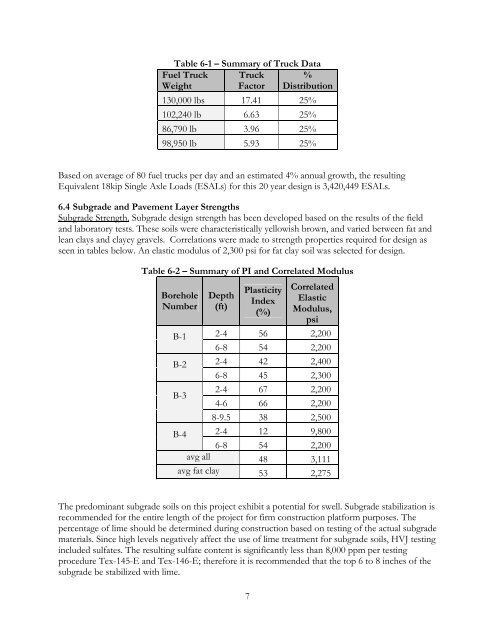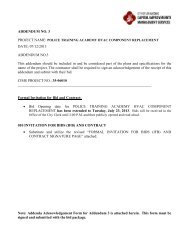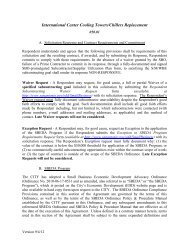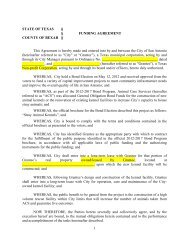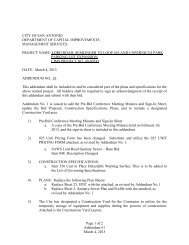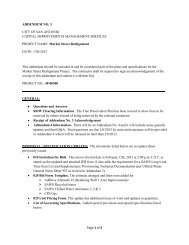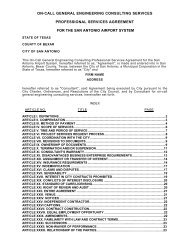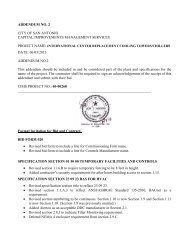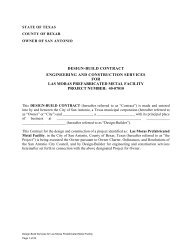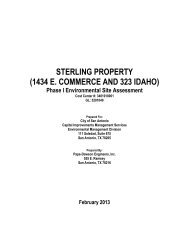Geotechnical Investigation Report - The City of San Antonio
Geotechnical Investigation Report - The City of San Antonio
Geotechnical Investigation Report - The City of San Antonio
- No tags were found...
Create successful ePaper yourself
Turn your PDF publications into a flip-book with our unique Google optimized e-Paper software.
Table 6-1 – Summary <strong>of</strong> Truck Data<br />
Truck<br />
Factor<br />
Fuel Truck<br />
Weight<br />
%<br />
Distribution<br />
130,000 lbs 17.41 25%<br />
102,240 lb 6.63 25%<br />
86,790 lb 3.96 25%<br />
98,950 lb 5.93 25%<br />
Based on average <strong>of</strong> 80 fuel trucks per day and an estimated 4% annual growth, the resulting<br />
Equivalent 18kip Single Axle Loads (ESALs) for this 20 year design is 3,420,449 ESALs.<br />
6.4 Subgrade and Pavement Layer Strengths<br />
Subgrade Strength. Subgrade design strength has been developed based on the results <strong>of</strong> the field<br />
and laboratory tests. <strong>The</strong>se soils were characteristically yellowish brown, and varied between fat and<br />
lean clays and clayey gravels. Correlations were made to strength properties required for design as<br />
seen in tables below. An elastic modulus <strong>of</strong> 2,300 psi for fat clay soil was selected for design.<br />
Table 6-2 – Summary <strong>of</strong> PI and Correlated Modulus<br />
Borehole<br />
Number<br />
Depth<br />
(ft)<br />
Plasticity<br />
Index<br />
(%)<br />
Correlated<br />
Elastic<br />
Modulus,<br />
psi<br />
B-1 2-4 56 2,200<br />
6-8 54 2,200<br />
B-2 2-4 42 2,400<br />
6-8 45 2,300<br />
B-3<br />
2-4 67 2,200<br />
4-6 66 2,200<br />
8-9.5 38 2,500<br />
B-4 2-4 12 9,800<br />
6-8 54 2,200<br />
avg all 48 3,111<br />
avg fat clay 53 2,275<br />
<strong>The</strong> predominant subgrade soils on this project exhibit a potential for swell. Subgrade stabilization is<br />
recommended for the entire length <strong>of</strong> the project for firm construction platform purposes. <strong>The</strong><br />
percentage <strong>of</strong> lime should be determined during construction based on testing <strong>of</strong> the actual subgrade<br />
materials. Since high levels negatively affect the use <strong>of</strong> lime treatment for subgrade soils, HVJ testing<br />
included sulfates. <strong>The</strong> resulting sulfate content is significantly less than 8,000 ppm per testing<br />
procedure Tex-145-E and Tex-146-E; therefore it is recommended that the top 6 to 8 inches <strong>of</strong> the<br />
subgrade be stabilized with lime.<br />
7


